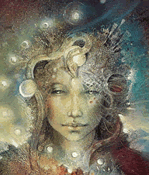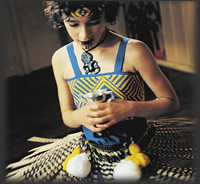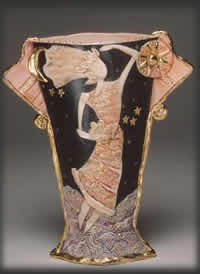The old and the new are in a constant state of tension; a particularly apt Sufi saying reminds us that the seeds of future consensus are sown in the heresy of the present. At times we all need our truth to be THE truth, when to admit anything else would be to risk the ground opening beneath us. At other times, however, we can afford to leave the door open, when we can welcome the unexpected visitor and ask “What might make this night different from all the rest?”

The goddess Athena
by Susan Seddon Boulet
It is edifying to see the equality of women in the list of Baha’i principles, even though the struggle for women’s rights—especially in the hallowed halls of religion—has more often brought strife. Nowhere is this more clearly illustrated than in the divisions in the Christian church that occurred following the ordination of women.
But it is not just parity in the right to represent—not to mention interpret—heaven’s intent in existing traditions that is being sought. Many are questioning the representation of the divine soley as masculine; in other words, the Goddess herself—in all her ancient stature and power—is now knocking at the door.

Pai,
The Whale Rider
© 2002 South Pacific Pictures Ltd
The desire of women to have equal say in the realm of religion is not purely a Western phenomenon. The 2002 film Whale Rider tells the story of an 11-year-old girl in a patriarchal New Zealand tribe. The Whangara people in the small Maori costal village believe their presence there dates back a thousand years or more to a single ancestor, Paikea, who escaped death when his canoe capsized by riding to shore on the back of a whale: from that moment on, Whangara chiefs—always the first-born, always male—have been considered Paikea’s direct descendants.
When twins are born, and the boy twin dies, Koro, the chief, is unable to accept his grand-daughter as a future leader. A few years later, he becomes convinced that the tribe’s misfortunes began at her birth; he calls for his people to bring their sons to him, in the hope that the new leader is among them. Pai loves her grandfather deeply, but in the end she is forced to stand up to him and a thousand years of tradition. Although a work of fiction, the film is nonetheless reflective of the situation of women in many parts of the world; the glory of it is such that it shows that the new way forward can occur without disaster, and that Pai and her grandfather are finally reconciled.

Miriam
cup
by Bonnie Cohen
Pai is not the only woman to take advantage of the opening of the door. As previously mentioned [A miraculous escape] there is a moment in the Jewish festival of Passover when a cup of wine is poured and the door opened for the return of the prophet Elijah. Nowadays, on some seder tables, a second cup has appeared; in growing numbers Jews are adding a Miriam cup to their Passover table, not only to remember the Old Testament prophetess, but as a step toward increasing the visibility of women in Judaism, and addressing their spiritual needs.
In recent years, Miriam, more than any other female biblical figure, has become a feminist heroine. The older sister of Moses, she prophesies his role and helps secure it by ensuring his survival as a baby. The inclusion of Miriam in the Passover ritual originated in the 1970s. While the cup of Elijah is filled with wine, her cup is filled with water. According to Jewish legend, a magical spring followed the Israelites during their forty years wandering in the wilderness after the exodus from Egypt; the waters of this spring were said to be healing and sustaining, and it was known as Miriam’s well, as it was her righteousness that had earned them this divine favour.
Psalm 121:1
An interesting fact came up in a poll undertaken for a programme broadcast by the BBC this February (“What the world thinks of God”), which was that the highest levels of faith were to be found in those nations most under stress. Some might see this as evidence that people in poorer countries were more likely to resort to religion. However I am inclined to believe that this is evidence that it is in times of our greatest need that the door opens to connect us to that which we perceive as at times within, at times as beyond us: a flaring forth of the fire of inspiration that comforts and supports, and replenishes our faith.
There is a symbolic language that comes naturally when trying to describe events saturated with meaning, and it is this mythic element in a sacred history that is most likely to be dismissed. However it is precisely this heightened vocabulary that can resonate on the deepest layers of soul, something that cannot be accomplished by a mere recitation of fact.
When Australian Aborigines chant the sacred stories as they walk along ancestral song-lines, when Christians follow the stations of the cross, they are seeking to pass through the door into an encounter with Mystery. As mentioned above, one person’s heresy is another’s exploration of the impossible questions we all come to consider, and when puzzling over a churinga, the cartoon-like drawings of a pre-Columbian codex, or the more esoteric passages of the Torah, the New Testament or the Guru Granth Sahib it is worth keeping in mind that all are the products of some human being trying to make sense of their experience.